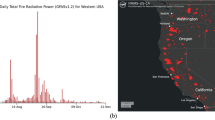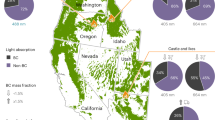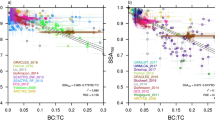Abstract
Biomass burning emits ~34–41 Tg yr−1 of smoke aerosol to the atmosphere. Biomass burning aerosol directly influences the Earth’s climate by attenuation of solar and terrestrial radiation; however, its abundance and distribution on a global scale are poorly constrained, particularly after plumes dilute into the background remote troposphere and are subject to removal by clouds and precipitation. Here we report global-scale, airborne measurements of biomass burning aerosol in the remote troposphere. Measurements were taken during four series of seasonal flights over the Pacific and Atlantic Ocean basins, each with near pole-to-pole latitude coverage. We find that biomass burning particles in the remote troposphere are dilute but ubiquitous, accounting for one-quarter of the accumulation-mode aerosol number and one-fifth of the aerosol mass. Comparing our observations with a high-resolution global aerosol model, we find that the model overestimates biomass burning aerosol mass in the remote troposphere with a mean bias of >400%, largely due to insufficient wet removal by in-cloud precipitation. After updating the model’s aerosol removal scheme we find that, on a global scale, dilute smoke contributes as much as denser plumes to biomass burning’s scattering and absorption effects on the Earth’s radiation field.
This is a preview of subscription content, access via your institution
Access options
Access Nature and 54 other Nature Portfolio journals
Get Nature+, our best-value online-access subscription
$29.99 / 30 days
cancel any time
Subscribe to this journal
Receive 12 print issues and online access
$259.00 per year
only $21.58 per issue
Buy this article
- Purchase on Springer Link
- Instant access to full article PDF
Prices may be subject to local taxes which are calculated during checkout




Similar content being viewed by others
Data availability
Data are publically available at https://daac.ornl.gov/ATOM/guides/ATom_merge.html and https://esrl.noaa.gov/csd/projects/atom/data.php.
Code availability
GEOS is an open-source model, and the code is available at https://gmao.gsfc.nasa.gov/GEOS_systems/.
Change history
25 June 2020
The ‘Editor recognition’ statement has been amended to additionally include the contribution of Xujia Jiang; the sentence now reads ‘Primary Handling Editors: Clare Davis; Xujia Jiang.’
References
Bond, T. C. et al. Bounding the role of black carbon in the climate system: a scientific assessment. J. Geophys. Res. Atmos. 118, 5380–5552 (2013).
Andreae, M. O. Emission of trace gases and aerosols from biomass burning—an updated assessment. Atmos. Chem. Phys. 19, 8523–8546 (2019).
Bowman, D. M. J. S. et al. Fire in the Earth System. Science 324, 481–484 (2009).
Abatzoglou, J. T. & Williams, A. P. Impact of anthropogenic climate change on wildfire across western US forests. Proc. Natl Acad. Sci. USA 113, 11770–11775 (2016).
Westerling, A. L., Hidalgo, H. G., Cayan, D. R. & Swetnam, T. W. Warming and earlier spring increase Western U.S. forest wildfire activity. Science 313, 940–943 (2006).
Hudson, P. K. et al. Biomass-burning particle measurements: characteristic composition and chemical processing. J. Geophys. Res. Atmos. 109, D23S27 (2004).
Park, R. J., Jacob, D. J. & Logan, J. A. Fire and biofuel contributions to annual mean aerosol mass concentrations in the United States. Atmos. Environ. 41, 7389–7400 (2007).
Edwards, D. P. et al. Satellite-observed pollution from Southern Hemisphere biomass burning. J. Geophys. Res. 111, D14312 (2006).
Wotawa, G. & Trainer, M. The influence of Canadian forest fires on pollutant concentrations in the United States. Science 288, 324–328 (2000).
Andreae, M. O., Andreae, T. W., Ferek, R. J. & Raemdonck, H. Long-range transport of soot carbon in the marine atmosphere. Sci. Total Environ. 36, 73–80 (1984).
Zuidema, P. et al. The Ascension Island boundary layer in the remote Southeast Atlantic is often smoky. Geophys. Res. Lett. 45, 4456–4465 (2018).
Dahlkötter, F. et al. The Pagami Creek smoke plume after long-range transport to the upper troposphere over Europe—aerosol properties and black carbon mixing state. Atmos. Chem. Phys. 14, 6111–6137 (2014).
Ditas, J. et al. Strong impact of wildfires on the abundance and aging of black carbon in the lowermost stratosphere. Proc. Natl Acad. Sci. USA 115, e11595–e11603 (2018).
Reddington, C. L. et al. The Global Aerosol Synthesis and Science Project (GASSP): measurements and modeling to reduce uncertainty. Bull. Am. Meteorol. Soc. 98, 1857–1877 (2017).
Myhre, G. et al. Radiative forcing of the direct aerosol effect from AeroCom Phase II simulations. Atmos. Chem. Phys. 13, 1853–1877 (2013).
Shi, Y. et al. A critical examination of spatial biases between MODIS and MISR aerosol products—application for potential AERONET deployment. Atmos. Meas. Techn. 4, 2823–2836 (2011).
Watson-Parris, D. et al. On the Limits of CALIOP for constraining modeled free tropospheric aerosol. Geophys. Res. Lett. 45, 9260–9266 (2018).
Thomson, D. S., Schein, M. E. & Murphy, D. M. Particle analysis by laser mass spectrometry WB-57F instrument overview. Aerosol Sci. Technol. 33, 153–169 (2000).
Cziczo, D. J., Thomson, D. S., Thompson, T. L., DeMott, P. J. & Murphy, D. M. Particle analysis by laser mass spectrometry (PALMS) studies of ice nuclei and other low number density particles. Int. J. Mass Spectrom. 258, 21–29 (2006).
Murphy, D. M. The design of single particle laser mass spectrometers. Mass Spectrom. Rev. 26, 150–165 (2007).
Froyd, K. D. et al. A new method to quantify mineral dust and other aerosol species from aircraft platforms using single-particle mass spectrometry. Atmos. Meas. Techn. 12, 6209–6239 (2019).
Brock, C. A. et al. Particle characteristics following cloud-modified transport from Asia to North America. J. Geophys. Res. 109, D23S26 (2004).
Sofiev, M., Ermakova, T. & Vankevich, R. Evaluation of the smoke-injection height from wild-land fires using remote-sensing data. Atmos. Chem. Phys. 12, 1995–2006 (2012).
Val Martin, M., Kahn, R. & Tosca, M. A global analysis of wildfire smoke injection heights derived from space-based multi-angle imaging. Remote Sens. 10, 1609 (2018).
Reid, J. S. et al. A review of biomass burning emissions part II: intensive physical properties of biomass burning particles. Atmos. Chem. Phys. 5, 799–825 (2005).
Li, J., Pósfai, M., Hobbs, P. V. & Buseck, P. R. Individual aerosol particles from biomass burning in southern Africa: 2, compositions and aging of inorganic particles. J. Geophys. Res. Atmos. 108, 8484 (2003).
Chin, M. et al. Tropospheric aerosol optical thickness from the GOCART model and comparisons with satellite and sun photometer measurements. J. Atmos. Sci. 59, 461–483 (2002).
Colarco, P., da Silva, A., Chin, M. & Diehl, T. Online simulations of global aerosol distributions in the NASA GEOS-4 model and comparisons to satellite and ground-based aerosol optical depth. J. Geophys. Res. 115, D14207 (2010).
Bian, H. et al. Source attributions of pollution to the Western Arctic during the NASA ARCTAS field campaign. Atmos. Chem. Phys. 13, 4707–4721 (2013).
Darmenov, A. & da Silva, A. M. The Quick Fire Emissions Dataset (QFED) – Documentation of Versions 2.1, 2.2 and 2.4 Technical Report Series on Global Modeling and Data Assimilation No. 32 (NASA, 2015).
Bian, Q. et al. Secondary organic aerosol formation in biomass-burning plumes: theoretical analysis of lab studies and ambient plumes. Atmos. Chem. Phys. 17, 5459–5475 (2017).
Petrenko, M. et al. The use of satellite-measured aerosol optical depth to constrain biomass burning emissions source strength in the global model GOCART. J. Geophys. Res. Atmos. 117, D18212 (2012).
Pan, X. et al. Six global biomass burning emission datasets: intercomparison and application in one global aerosol model. Atmos. Chem. Phys. 20, 969–994 (2020).
Schwarz, J. P. et al. Global‐scale seasonally resolved black carbon vertical profiles over the Pacific. Geophys. Res. Lett. 40, 5542–5547 (2013).
Yu, P. et al. Efficient in-cloud removal of aerosols by deep convection. Geophys. Res. Lett. 46, 1061–1069 (2019).
Lund, M. T. et al. Short black carbon lifetime inferred from a global set of aircraft observations. npj Clim. Atmos. Sci. 1, 31 (2018).
Toth, T. D. et al. Minimum aerosol layer detection sensitivities and their subsequent impacts on aerosol optical thickness retrievals in CALIPSO level 2 data products. Atmos. Meas. Tech. 11, 499–514 (2018).
Samset, B. H. & Myhre, G. Climate response to externally mixed black carbon as a function of altitude. J. Geophys. Res. Atmos. 120, 2913–2927 (2015).
Tegen, I. & Heinold, B. Large-scale modeling of absorbing aerosols and their semi-direct effects. Atmosphere 9, 380 (2018).
Mallet, M. et al. Simulation of the transport, vertical distribution, optical properties and radiative impact of smoke aerosols with the ALADIN regional climate model during the ORACLES-2016 and LASIC experiments. Atmos. Chem. Phys. 19, 4963–4990 (2019).
Toon, O. B. et al. Planning, implementation, and scientific goals of the Studies of Emissions and Atmospheric Composition, Clouds and Climate Coupling by Regional Surveys (SEAC 4 RS) field mission. J. Geophys. Res. Atmos. 121, 4967–5009 (2016).
Brock, C. A. et al. Aerosol size distributions during the Atmospheric Tomography Mission (ATom): methods, uncertainties, and data products. Atmos. Meas. Tech. 12, 3081–3099 (2019).
Murphy, D. M. et al. The distribution of sea-salt aerosol in the global troposphere. Atmos. Chem. Phys. 19, 4093–4104 (2019).
Williamson, C. et al. Fast time response measurements of particle size distributions in the 3–60 nm size range with the nucleation mode aerosol size spectrometer. Atmos. Meas. Tech. 11, 3491–3509 (2018).
Kupc, A., Williamson, C., Wagner, N. L., Richardson, M. & Brock, C. A. Modification, calibration, and performance of the Ultra-High Sensitivity Aerosol Spectrometer for particle size distribution and volatility measurements during the Atmospheric Tomography Mission (ATom) airborne campaign. Atmos. Meas. Tech. 11, 369–383 (2018).
McNaughton, C. S. et al. Results from the DC-8 Inlet Characterization Experiment (DICE): airborne versus surface sampling of mineral dust and sea salt aerosols. Aerosol Sci. Technol. 41, 136–159 (2007).
Brockmann, J. E. in Aerosol Measurement (eds Kulkarni, P. et al.) Ch. 6 (John Wiley & Sons, 2011).
Loo, B. W. & Cork, C. P. Development of high efficiency virtual impactors. Aerosol Sci. Technol. 9, 167–176 (1988).
Huebert, B. J., Lee, G. & Warren, W. L. Airborne aerosol inlet passing efficiency measurement. J. Geophys. Res. 95, 16369–16381 (1990).
Weber, R. J. et al. Spurious aerosol measurements when sampling from aircraft in the vicinity of clouds. J. Geophys. Res. Atmos. 103, 28337–28346 (1998).
Murphy, D. M. et al. Particle generation and resuspension in aircraft inlets when flying in clouds. Aerosol Sci. Technol. 38, 401–409 (2004).
Murphy, D. M., Middlebrook, A. M. & Warshawsky, M. Cluster analysis of data from the Particle Analysis by Laser Mass Spectrometry (PALMS) instrument. Aerosol Sci. Technol. 37, 382–391 (2003).
Cziczo, D. J., Thomson, D. S. & Murphy, D. M. Ablation, flux, and atmospheric implications of meteors inferred from stratospheric aerosol. Science 291, 1772–1775 (2001).
Sullivan, A. P. et al. Biomass burning markers and residential burning in the WINTER aircraft campaign. J. Geophys. Res. Atmos. 124, 1846–1861 (2019).
Cziczo, D. J. et al. Observations of organic species and atmospheric ice formation. Geophys. Res. Lett. 31, L12116 (2004).
Rienecker, M. M. et al. The GEOS-5 Data Assimilation System: Documentation of Versions 5.0. 1, 5.1. 0, and 5.2. 0 Technical Report Series on Global Modeling and Data Assimilation No. 27 (NASA, 2008).
Liu, H., Jacob, D. J., Bey, I. & Yantosca, R. M. Constraints from 210Pb and 7Be on wet deposition and transport in a global three-dimensional chemical tracer model driven by assimilated meteorological fields. J. Geophys. Res. Atmos. 106, 12109–12128 (2001).
Randles, C. A. et al. The MERRA-2 aerosol reanalysis, 1980 Onward. Part I: system description and data assimilation evaluation. J. Clim. 30, 6823–6850 (2017).
Chou, M. & Suarez, M. J. A Solar Radiation Parameterization for Atmospheric Studies Technical Report Series on Global Modeling and Data Assimilation No. 15 (NASA, 1999).
Apel, E. C. et al. Upper tropospheric ozone production from lightning NOx-impacted convection: smoke ingestion case study from the DC3 campaign. J. Geophys. Res. Atmos. 120, 2505–2523 (2015).
Wang, S. et al. Atmospheric acetaldehyde: importance of air–sea exchange and a missing source in the remote troposphere. Geophys. Res. Lett. 46, 5601–5613 (2019).
Bowman, K. P. Large-scale isentropic mixing properties of the Antarctic polar vortex from analyzed winds. J. Geophys. Res. 98, 23013 (1993).
Bowman, K. P. & Carrie, G. D. The mean-meridional transport circulation of the troposphere in an idealized GCM. J. Atmos. Sci. 59, 1502–1514 (2002).
Schroeder, W., Oliva, P., Giglio, L. & Csiszar, I. A. The new VIIRS 375 m active fire detection data product: algorithm description and initial assessment. Remote Sens. Environ. 143, 85–96 (2014).
Acknowledgements
The mission as a whole was supported by NASA’s Earth System Science Pathfinder Program EVS-2 funding. Participation in ATom Mission flights by G.P.S., K.D.F., C.W., C.A.B. and D.M.M. was supported by NOAA climate funding (no. NNH15AB12I). A.K. was supported by the Austrian Science Fund’s Erwin Schrodinger Fellowship (no. J-3613). R.S.H., A.J.H. and E.C.A. received support from the National Center for Atmospheric Research, which is a major facility sponsored by the NSF under Cooperative Agreement no. 1852977.
Author information
Authors and Affiliations
Contributions
G.P.S., K.D.F. and D.M.M. provided PALMS data. H.B., M.C. and P.R.C. provided GEOS/GOCART results. A.K., C.W. and C.A.B. provided size distribution data. E.R. provided back-trajectory results. R.S.H., A.J.H. and E.C.A. provided TOGA data. G.P.S. wrote the paper with assistance from all authors.
Corresponding author
Ethics declarations
Competing interests
The authors declare no competing interests.
Additional information
Peer review information Primary Handling Editors: Clare Davis; Xujia Jiang.
Publisher’s note Springer Nature remains neutral with regard to jurisdictional claims in published maps and institutional affiliations.
Supplementary information
Supplementary Information
Supplementary Figs. 1–5 and Tables 1 and 2.
Rights and permissions
About this article
Cite this article
Schill, G.P., Froyd, K.D., Bian, H. et al. Widespread biomass burning smoke throughout the remote troposphere. Nat. Geosci. 13, 422–427 (2020). https://doi.org/10.1038/s41561-020-0586-1
Received:
Accepted:
Published:
Issue Date:
DOI: https://doi.org/10.1038/s41561-020-0586-1
This article is cited by
-
Light absorption properties of black carbon and brown carbon emitted from biomass combustion at the typical rural cooking stoves in Bangladesh
Air Quality, Atmosphere & Health (2023)
-
Rapid growth and high cloud-forming potential of anthropogenic sulfate aerosol in a thermal power plant plume during COVID lockdown in India
npj Climate and Atmospheric Science (2023)
-
Dominant role of mineral dust in cirrus cloud formation revealed by global-scale measurements
Nature Geoscience (2022)
-
Using modelled relationships and satellite observations to attribute modelled aerosol biases over biomass burning regions
Nature Communications (2022)
-
Characterization of aerosol particles during a high pollution episode over Mexico City
Scientific Reports (2021)



